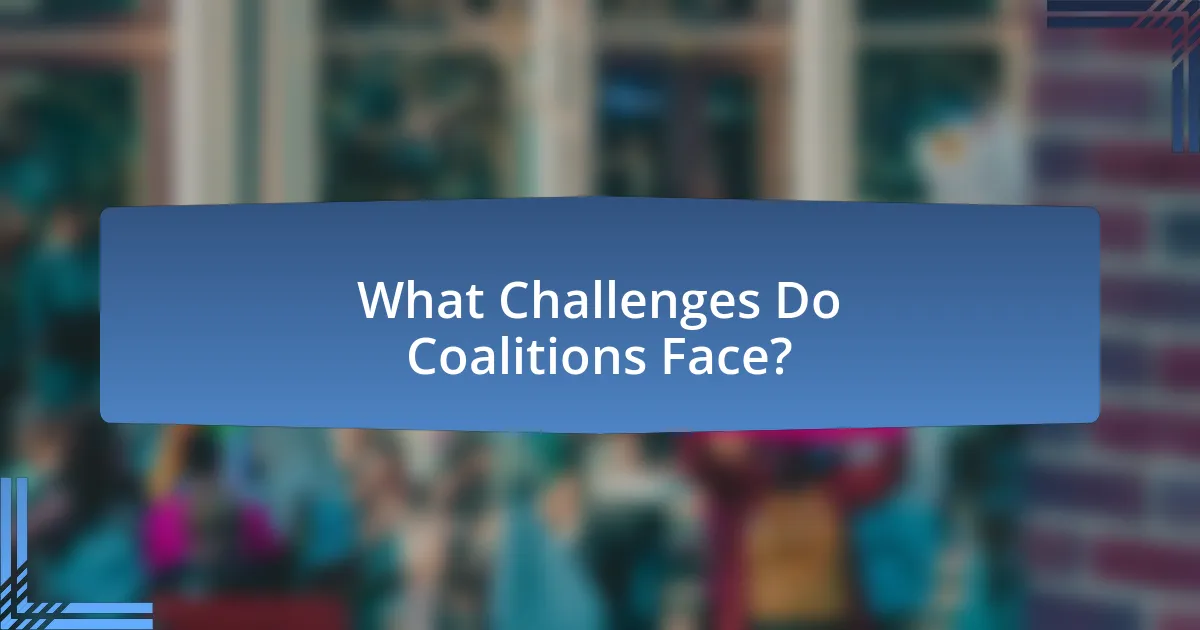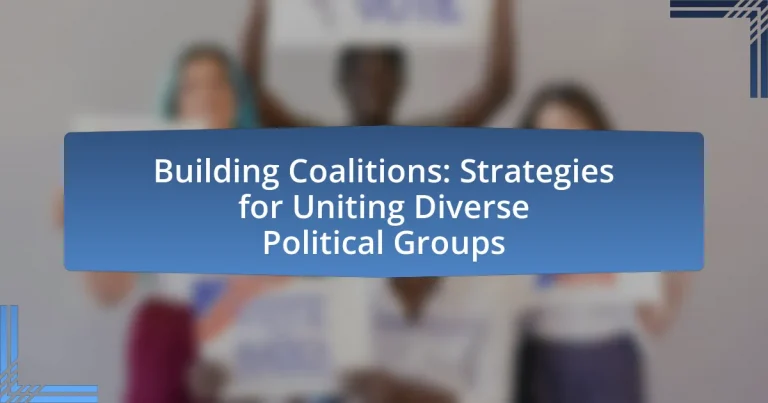The article focuses on the concept of coalitions in a political context, defining them as alliances formed between different political parties or groups to achieve common legislative goals, particularly when no single party holds a majority. It emphasizes the importance of coalitions in enhancing collective power, influencing policy-making, and navigating complex political landscapes, supported by historical examples such as the Allied Powers in World War II and the United Nations. The article further categorizes coalitions into types, discusses strategies for building effective coalitions, and addresses challenges faced, including differing agendas and communication barriers, while highlighting best practices for fostering trust and collaboration among diverse political entities.

What are Coalitions in Political Context?
Coalitions in a political context are alliances formed between different political parties or groups to achieve common goals, particularly in legislative decision-making. These alliances often emerge when no single party holds a majority, necessitating collaboration to pass laws or govern effectively. For example, in parliamentary systems, coalitions can lead to stable governments by combining resources and support from various factions, as seen in countries like Germany and Israel, where coalition governments are a common practice.
Why are Coalitions Important in Politics?
Coalitions are important in politics because they enable diverse groups to unite and achieve common goals, thereby increasing their collective power and influence. By forming coalitions, political entities can pool resources, share expertise, and broaden their support base, which is essential in systems where majority support is necessary for passing legislation or winning elections. Historical examples, such as the coalition government in the United Kingdom post-2010 elections, demonstrate how parties can collaborate to form a stable government despite differing ideologies, illustrating the practical necessity of coalitions in navigating complex political landscapes.
What historical examples illustrate the significance of coalitions?
Historical examples that illustrate the significance of coalitions include the formation of the Allied Powers during World War II and the United Nations. The Allied Powers, consisting of countries like the United States, the United Kingdom, and the Soviet Union, united against the Axis Powers, demonstrating how diverse nations can collaborate to achieve a common goal of defeating a common enemy. This coalition was crucial in turning the tide of the war, leading to the eventual defeat of Nazi Germany and its allies in 1945.
Similarly, the establishment of the United Nations in 1945 represented a coalition of nations aimed at promoting peace, security, and cooperation on a global scale. The UN was formed in response to the devastation of World War II, highlighting the need for a collaborative approach to prevent future conflicts. The effectiveness of these coalitions underscores the importance of unity among diverse political groups in addressing significant global challenges.
How do coalitions influence policy-making?
Coalitions influence policy-making by uniting diverse political groups to amplify their collective power and advocacy efforts. This collaboration enables them to present a unified front, which can sway legislators and decision-makers more effectively than individual entities. For instance, coalitions often pool resources, share expertise, and coordinate strategies to address specific issues, thereby increasing their visibility and impact on policy discussions. Research shows that coalitions can lead to significant legislative outcomes; for example, the Health Care for America Now coalition successfully mobilized support for the Affordable Care Act in 2010 by bringing together various stakeholders, including labor unions, healthcare providers, and advocacy groups, demonstrating the effectiveness of collective action in shaping policy.
What Types of Political Coalitions Exist?
Political coalitions can be categorized into several types, including electoral coalitions, legislative coalitions, and issue-based coalitions. Electoral coalitions are formed by political parties or groups to enhance their chances of winning elections, often by pooling resources and votes. Legislative coalitions occur when parties or groups collaborate within a legislative body to achieve common goals, such as passing specific legislation or influencing policy decisions. Issue-based coalitions unite diverse groups around a specific cause or policy, allowing them to advocate collectively for change. These coalitions are essential in political systems, as they enable collaboration among varied interests to achieve shared objectives.
What are the differences between formal and informal coalitions?
Formal coalitions are structured alliances with established rules, roles, and procedures, while informal coalitions are more flexible and based on personal relationships and shared interests without formal agreements. Formal coalitions often involve official documentation, designated leadership, and specific objectives, which can enhance accountability and clarity in decision-making. In contrast, informal coalitions rely on trust and mutual understanding, allowing for quicker adaptations to changing circumstances. Research indicates that formal coalitions can lead to more sustainable outcomes due to their organized nature, while informal coalitions can foster innovation and responsiveness due to their less rigid structure.
How do issue-based coalitions differ from party coalitions?
Issue-based coalitions focus on specific issues or causes, while party coalitions are formed around political parties and their broader platforms. Issue-based coalitions unite diverse groups based on shared interests, such as environmental protection or healthcare reform, regardless of their political affiliations. In contrast, party coalitions align members of a particular political party to achieve common electoral goals or legislative agendas. For example, the environmental movement may bring together activists from various political backgrounds to advocate for climate policies, whereas a party coalition would consist of members from a single political party working to advance that party’s overall agenda. This distinction highlights the flexibility of issue-based coalitions in addressing specific concerns compared to the more structured and ideologically driven nature of party coalitions.

What Strategies are Effective for Building Coalitions?
Effective strategies for building coalitions include establishing common goals, fostering open communication, and leveraging diverse strengths. Establishing common goals ensures that all members are aligned in their objectives, which enhances collaboration. Fostering open communication allows for transparency and trust, enabling members to voice concerns and share ideas freely. Leveraging diverse strengths involves recognizing and utilizing the unique skills and resources each member brings to the coalition, which can enhance problem-solving and innovation. Research by the National Civic League indicates that coalitions with clear goals and strong communication are more likely to succeed in achieving their objectives.
How can leaders identify potential coalition partners?
Leaders can identify potential coalition partners by assessing shared goals, values, and interests among various groups. This involves conducting stakeholder analysis to pinpoint organizations or individuals that align with their objectives and have a vested interest in collaboration. For instance, leaders can utilize surveys or interviews to gather insights on priorities and concerns from potential partners, ensuring compatibility. Additionally, analyzing past collaborations and existing networks can reveal historical alliances that may facilitate new partnerships. Research indicates that successful coalitions often emerge from a foundation of mutual benefit and trust, highlighting the importance of establishing rapport before formalizing partnerships.
What criteria should be used to evaluate potential partners?
To evaluate potential partners in building coalitions, criteria should include shared goals, complementary strengths, and mutual trust. Shared goals ensure alignment in objectives, which is crucial for effective collaboration. Complementary strengths allow partners to leverage each other’s resources and expertise, enhancing the coalition’s overall capability. Mutual trust fosters open communication and commitment, essential for navigating challenges together. Research indicates that coalitions with clearly defined shared goals and trust among partners are more successful in achieving their objectives, as evidenced by studies on collaborative governance (Ansell & Gash, 2008).
How can shared goals facilitate coalition formation?
Shared goals facilitate coalition formation by providing a common purpose that aligns the interests of diverse groups. When political entities identify and agree on specific objectives, they can overcome differences and collaborate effectively. For instance, research shows that coalitions formed around shared goals, such as environmental protection or social justice, tend to be more cohesive and successful in achieving their aims. This alignment fosters trust and encourages resource sharing, ultimately enhancing the coalition’s strength and influence in the political landscape.
What Communication Strategies Enhance Coalition Building?
Effective communication strategies that enhance coalition building include active listening, clear messaging, and fostering inclusive dialogue. Active listening allows coalition members to understand diverse perspectives, which builds trust and encourages collaboration. Clear messaging ensures that all members are aligned on goals and objectives, reducing misunderstandings. Fostering inclusive dialogue creates an environment where all voices are heard, promoting engagement and commitment among coalition partners. Research indicates that coalitions with strong communication practices are more successful in achieving their objectives, as evidenced by studies showing that effective communication correlates with higher levels of member satisfaction and goal attainment.
How can effective messaging unify diverse groups?
Effective messaging can unify diverse groups by creating a shared narrative that resonates with the values and experiences of all members. This approach fosters inclusivity and encourages collaboration by emphasizing common goals and mutual benefits. Research indicates that messages framed around collective identity and shared aspirations can significantly enhance group cohesion, as seen in political campaigns that successfully unite various demographics by highlighting overarching themes such as justice, equality, and community well-being. For instance, the 2008 Obama campaign effectively utilized messaging that appealed to a broad spectrum of voters, resulting in increased voter turnout across diverse populations.
What role does transparency play in coalition dynamics?
Transparency is crucial in coalition dynamics as it fosters trust among members, enhances communication, and facilitates decision-making. When coalition partners are transparent about their intentions, goals, and actions, it reduces the likelihood of misunderstandings and conflicts. For instance, research by the International Institute for Democracy and Electoral Assistance highlights that transparent processes in coalition negotiations lead to more stable and effective partnerships. This stability is essential for achieving common objectives and maintaining coalition integrity over time.

What Challenges Do Coalitions Face?
Coalitions face several challenges, including differing agendas, communication barriers, and power imbalances. Differing agendas can lead to conflicts over priorities and resource allocation, making it difficult for coalition members to agree on a unified strategy. Communication barriers often arise from diverse backgrounds and perspectives, which can hinder effective collaboration and decision-making. Additionally, power imbalances among coalition members can create tensions, as more influential groups may dominate discussions and decision processes, marginalizing smaller or less powerful participants. These challenges can impede the coalition’s ability to achieve its goals and maintain cohesion.
What are common obstacles in coalition building?
Common obstacles in coalition building include differing priorities among groups, lack of trust, and communication barriers. Differing priorities can lead to conflicts over goals and strategies, making it difficult to find common ground. Lack of trust often arises from past experiences or perceived inequities, hindering collaboration. Communication barriers, such as language differences or varying terminologies, can further complicate interactions and understanding among coalition members. These obstacles can significantly impede the effectiveness and sustainability of coalitions, as evidenced by various studies highlighting the importance of alignment and trust in successful coalition efforts.
How can conflicting interests hinder coalition effectiveness?
Conflicting interests can significantly hinder coalition effectiveness by creating divisions among members, leading to a lack of trust and cooperation. When coalition members prioritize their individual goals over collective objectives, it results in misalignment and inefficiency in decision-making processes. For instance, research by the Harvard Kennedy School indicates that coalitions with divergent interests often struggle to reach consensus, which can stall initiatives and diminish overall impact. This fragmentation can also lead to weakened commitment, as members may withdraw support if they feel their interests are not being adequately represented.
What strategies can mitigate internal conflicts within coalitions?
Effective strategies to mitigate internal conflicts within coalitions include establishing clear communication channels, fostering mutual respect, and implementing conflict resolution mechanisms. Clear communication ensures that all coalition members understand goals and expectations, reducing misunderstandings that can lead to conflict. Fostering mutual respect among diverse members encourages collaboration and minimizes friction, as individuals feel valued and heard. Additionally, implementing structured conflict resolution mechanisms, such as mediation or facilitated discussions, provides a formal process for addressing disputes, which can prevent escalation and promote a cooperative atmosphere. These strategies are supported by research indicating that effective communication and structured conflict resolution significantly enhance group cohesion and performance in collaborative settings.
How can coalitions adapt to changing political landscapes?
Coalitions can adapt to changing political landscapes by continuously assessing their goals, strategies, and member dynamics in response to shifts in public opinion and political power. This adaptability is crucial for maintaining relevance and effectiveness, as evidenced by historical examples such as the Democratic Party’s evolution in response to changing demographics and social movements in the United States. By engaging in regular dialogue among coalition members and stakeholders, coalitions can realign their objectives and strategies to reflect current political realities, ensuring they remain united and focused on common goals.
What role does flexibility play in coalition sustainability?
Flexibility is crucial for coalition sustainability as it allows diverse political groups to adapt to changing circumstances and negotiate effectively. When coalition members can adjust their positions and strategies in response to new information or shifting political landscapes, they enhance their ability to maintain unity and achieve common goals. Research indicates that coalitions with flexible frameworks are more likely to endure, as they can accommodate varying interests and priorities among members, thereby fostering collaboration and reducing conflict. For instance, a study by the National Democratic Institute highlights that adaptable coalitions can better respond to electoral challenges, leading to increased longevity and effectiveness in political engagement.
How can coalitions respond to external pressures and crises?
Coalitions can respond to external pressures and crises by implementing adaptive strategies that enhance their resilience and effectiveness. These strategies include fostering open communication among members, which allows for rapid information sharing and collective decision-making during crises. For instance, during the COVID-19 pandemic, various coalitions in public health adapted by sharing data and resources, enabling them to respond more effectively to emerging challenges. Additionally, coalitions can engage in scenario planning to anticipate potential crises and develop contingency plans, thereby ensuring preparedness. Research shows that coalitions that prioritize flexibility and collaboration are better equipped to navigate external pressures, as evidenced by the successful responses of international coalitions during global economic downturns.
What Best Practices Should Be Followed in Coalition Building?
Effective coalition building requires clear communication, shared goals, and mutual respect among diverse groups. Establishing a common purpose aligns the interests of coalition members, fostering collaboration. Regular meetings and open dialogue enhance transparency and trust, which are essential for maintaining relationships. Additionally, recognizing and valuing the unique contributions of each member strengthens the coalition’s foundation. Research indicates that coalitions with defined roles and responsibilities are more successful in achieving their objectives, as seen in the work of the National Coalition for the Homeless, which emphasizes structured participation.
How can coalition leaders foster trust among members?
Coalition leaders can foster trust among members by promoting transparency and open communication. When leaders share information openly and encourage dialogue, members feel valued and included, which strengthens relationships. Research indicates that transparency in decision-making processes leads to higher levels of trust; for instance, a study published in the Journal of Business Ethics found that organizations with transparent practices experience increased trust among stakeholders. Additionally, coalition leaders should actively listen to members’ concerns and feedback, demonstrating that their voices matter, which further enhances trust within the group.
What are the key elements of a successful coalition agreement?
The key elements of a successful coalition agreement include clear objectives, mutual respect, effective communication, and a framework for decision-making. Clear objectives ensure that all parties understand the goals of the coalition, which is essential for alignment and cooperation. Mutual respect fosters trust among coalition members, enabling them to work together despite differing ideologies. Effective communication facilitates transparency and helps to resolve conflicts promptly. A well-defined framework for decision-making allows for efficient governance and accountability, ensuring that all voices are heard and considered. These elements are critical for maintaining cohesion and achieving the coalition’s aims.


